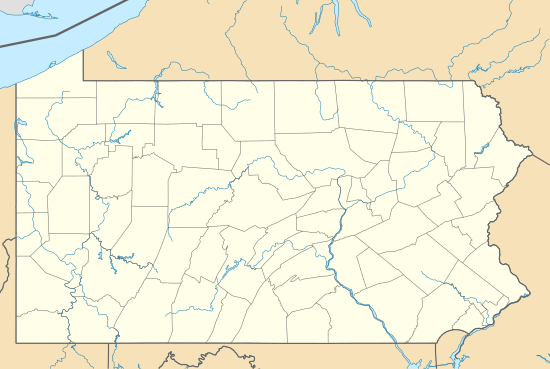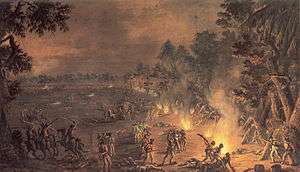Battle of Paoli
| ||||||||||||||||||||||||||||||
The Battle of Paoli (also known as the Battle of Paoli Tavern or the Paoli Massacre) was a battle in the Philadelphia campaign of the American Revolutionary War fought on September 20, 1777, in the area surrounding present-day Malvern, Pennsylvania. Following the American retreats at the Battle of Brandywine and the Battle of the Clouds, George Washington left a force under Brigadier General Anthony Wayne behind to monitor and harass the British as they prepared to move on the revolutionary capital of Philadelphia. On the evening of September 20, British forces under Major General Charles Grey led a surprise attack on Wayne's encampment near the Paoli Tavern. Although there were relatively few American casualties, claims were made that the British took no prisoners and granted no quarter, and the engagement became known as the "Paoli Massacre."
Background
After the American defeat at the Battle of Brandywine, American Major General George Washington was intent on accomplishing two tasks. He wanted to protect Philadelphia from British forces under the command of Lieutenant General William Howe, and he needed to replenish the rapidly dwindling supplies and munitions stored in Reading, Pennsylvania. Washington withdrew across the Schuylkill River, marched through Philadelphia, and headed northwest. Since the Schuylkill was fordable only far upstream starting at Matson's Ford (present-day Conshohocken), Washington could protect both the capital and the vital supply areas to the west from behind the river barrier. Washington reconsidered, and recrossed the river to face the British, who had moved little since Brandywine, due to a shortage of wagons to carry their wounded and their baggage.[3] After the Battle of the Clouds was aborted by bad weather on September 16, Washington again withdrew across the Schuylkill, leaving Brigadier General "Mad" Anthony Wayne's Pennsylvania Division at Chester, Pennsylvania. When the British columns passed by, Wayne followed, under orders from Washington to harass the British and attempt to capture all or part of their baggage train.
Wayne assumed that his presence was undetected and camped close to the British lines in Paoli, Pennsylvania. His division consisted of the 1st, 2nd, 4th, 5th, 7th, 8th, 10th and 11th Pennsylvania Regiments, Hartley's Regiment, an attached artillery company and a small force of dragoons. All told, it was about 1,500 strong. Camped about 1 mile (1.6 km) away was William Smallwood's Maryland militia, about 2,100 relatively inexperienced troops.
The British heard rumors that Wayne was in the area, and General Howe sent out spies who reported his location near the Paoli Tavern on September 19. Since his position was just 4 miles (6.4 km) from the British camp at Tredyffrin, Pennsylvania, Howe immediately planned an attack on Wayne's relatively exposed camp.
Battle
At 10 p.m. on September 20, British commander Major General Charles Grey marched from the British camp, and launched a surprise attack on Wayne's camp, near the General Paoli Tavern, from which the battle takes its name, located near present-day Malvern. Grey's troops consisted of the 2nd Light Infantry, a composite battalion formed from the light companies of 13 regiments, plus the 42nd and 44th Foot. Altogether, his brigade comprised some 1,200 men.
To ensure that the Americans were not alerted, Grey had the flints removed from his troop's muskets, earning him the nickname "No Flint" Grey.
The British, led by a local blacksmith forced to act as guide, approached the camp from a wood and were able to achieve complete surprise. They stormed the camp in three waves—the 2nd Light Infantry in the lead followed by the 44th and the 42nd. Completely unprepared, Wayne's troops fled from the camp and were pursued. Near the White Horse Tavern the British encountered Smallwood's force and routed it as well.
With casualties of only 4 killed and 7 wounded,[2] the British had routed an entire American division. Historian Thomas J. McGuire says that 53 Americans were buried on the battlefield but "whether these were all of the American dead or only those found on the campsite-battlefield is uncertain".[1] Local tradition says that 8 more Americans killed in the battle were buried at the nearby Anglican church of St. Peter-in-the-Great Valley.[1][4] 71 prisoners were taken by the British, 40 of whom were so badly wounded that they had to be left behind in nearby houses.[5] A total of 272 men were killed, wounded or missing from Wayne's division after the battle.[1]
Aftermath
An official inquiry found that Wayne was not guilty of misconduct but that he had made a tactical error. Wayne was enraged and demanded a full court-martial. On November 1, a board of 13 officers declared that Wayne had acted with honor.
The incident gained notoriety partly because of accounts by eyewitnesses who stated that the British had stabbed or mutilated Americans who tried to surrender. Among them were the following:
"I with my own Eyes, see them, cut & hack some of our poor Men to pieces after they had fallen in their hands and scarcely shew the least Mercy to any..." - Lt. Col. Adam Hubley, 10th PA Regiment. [6]
"...more than a dozen soldiers had with fixed bayonets formed a cordon round him, and that everyone of them in sport had indulged their brutal ferocity by stabbing him in different parts of his body and limbs ... a physician ... examining him there was found ... 46 distinct bayonet wounds..." - William Hutchinson, Pennsylvania Militiaman. [7]
"The Enemy last Night at twelve o'clock attacked ... Our Men just raised from Sleep, moved disorderly — Confusion followed ... The Carnage was very great ... this is a bloody Month." - Col. Thomas Hartley, 1st PA Regiment. [8]
"The Annals of the Age Cannot Produce such another Scene of Butchery..." - Maj. Samuel Hay, 7th PA Regiment. [6]
There were no Geneva Conventions in place at that time, although most Western powers subscribed to an informal but generally recognized "Laws of War" which were intended to rein in some of the worst abuses of both prisoners and the civil population in time of war.
Moreover, George III had declared the colonies to be in rebellion, and thus traitors to the Crown, a charge which denied prisoners PoW status and carried a maximum penalty of death by "hanging, drawing and quartering", a form of execution which dated from the reign of Henry III (1216–1272) and remained in use until the early 19th century and on the books until 1870. Earlier examples of British mistreatment of alleged "rebels" include the massacre of many of the wounded Jacobites on the field of Culloden (1746). A number of the prisoners were then later treated brutally and starved before being hanged, drawn and quartered.
In the American Revolution, though the British (as a result of various government strategies intended to minimize resistance) did take prisoners, and did not regularly massacre the wounded and prisoners, there were a number of incidents, such as the action on 1 February 1777 at Drake's Farm (during the campaign known as the Forage War. After the action, Lieutenant William Kelly and six other wounded Americans of Charles Scott's 5th Virginia were abandoned during the American withdrawal. The British fell upon the seven helpless men with bayonets and musket butts and slaughtered them all. When the Americans recovered the mangled bodies they were infuriated.
Writing on the other side of the question, military historian Mark M. Boatner III wrote:
"American propagandists succeeded in whipping up anti-British sentiment with false accusations that Grey's men had refused quarter and massacred defenseless patriots who tried to surrender ... The 'no quarter' charge is refuted by the fact that the British took 71 prisoners. The “mangled dead” is explained by the fact that the bayonet is a messy weapon".[5]
In any case, Wayne's troops swore revenge and "Remember Paoli!" was used by them as a battle cry at Germantown and at Stony Point.
There is a tradition that, to show their defiance, the men of the 2nd Light Infantry dyed their hat feathers red so the Americans would be able to identify them. In 1833, the Light Company of the 46th Regiment were authorized to wear red cap distinctions instead of the regulation Light Infantry green,[9] apparently in commemoration of this gesture, and in 1934, the Royal Berkshire Regiment, which carried on the traditions of the 49th Foot, were authorized to wear a red distinction in their head dress although, misleadingly, this was granted 'to commemorate the role of the Light Company at the battle of Brandywine Creek'.[10] In the second half of the 20th century, the descendants of both regiments wore red backing to their cap badges and did so until 2006 when The Light Infantry and the Royal Gloucestershire, Berkshire and Wiltshire Regiment were absorbed by The Rifles.
Monument
|
Paoli Battlefield Site and Parade Grounds | |
|
The present-day monument at the site of the battle | |
  | |
| Location | Roughly bounded by Warren, and Monument Aves., and Sugartown Rd., Malvern, Pennsylvania |
|---|---|
| Coordinates | 40°01′47″N 75°31′06″W / 40.02972°N 75.51833°WCoordinates: 40°01′47″N 75°31′06″W / 40.02972°N 75.51833°W |
| Area | 62.2 acres (25.2 ha) |
| Built | 1817, 1877 |
| Architect | John T. Windrim, Palmer C. Hughes |
| Architectural style | Colonial Revival, Late 19th And 20th Century Revivals |
| NRHP Reference # | 97001248[11] |
| Added to NRHP | October 23, 1997 |
In 1877, a granite monument was erected at the site of the battle. It stands 22.5 feet (6.9 m) tall and is inscribed on all four sides.[12] It is located in a local park in Malvern that was listed on the National Register of Historic Places in 1997 as the Paoli Battlefield Site and Parade Grounds.[11] There are two contributing buildings, two contributing sites, and five contributing objects included on the listing. They are the Paoli Battlefield Site, Paoli Parade Grounds, Paoli Massacre Monument (1817), Paoli Massacre obelisk (1877), World War I monument (1928), World War II urn (c. 1946), and caretaker's house and garage (1922).[13]
Footnotes
- 1 2 3 4 5 McGuire p.146
- 1 2 3 McGuire p.132
- ↑ McGuire, p. 30
- ↑ See also
- 1 2 Boatner p.829
- 1 2 McGuire p.125
- ↑ McGuire p.130
- ↑ McGuire p.109
- ↑ War Office WO 3/440
- ↑ War Office letter No 54/OFFICERS/30 Ya (MGO.Yb);China Dragon, No 94. July 1934
- 1 2 National Park Service (2010-07-09). "National Register Information System". National Register of Historic Places. National Park Service.
- ↑ "1877 Paoli Monument". ushistory.org. Independence Hall Association. Retrieved November 22, 2009.
- ↑ "National Historic Landmarks & National Register of Historic Places in Pennsylvania" (Searchable database). CRGIS: Cultural Resources Geographic Information System. Note: This includes Jane L.S. Davidson and Thomas J. McGuire (May 1997). "National Register of Historic Places Inventory Nomination Form: Paoli Battlefield Site and Parade Grounds" (PDF). Retrieved 2012-10-30.
References
- Boatner, Mark Mayo, Cassell's Biographical Dictionary of the American War of Independence 1763-1783, Cassell, London, 1966, ISBN 0-304-29296-6
- McGuire, Thomas J. Battle of Paoli. Mechanicsburg, PA: Stackpole Books, 2000, ISBN 0-8117-0198-0
- "1877 Paoli Monument". ushistory.org. Independence Hall Association. Retrieved November 22, 2009.
- Proceedings on the occasion of the dedication of the monument on the One Hundred Anniversary of the Paoli Massacre in Chester Co PA September 20, 1877
External links
- Paoli Battlefield Preservation Fund
- Paoli Massacre page at USHistory.org
- Paoli Memorial at Find A Grave



